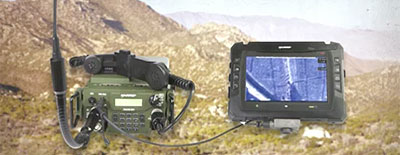|
Harris RF-3590
Harris introduces rugged 7-inch Android-based tablet for mission-critical defense and public safety deployments
(by Conrad H. Blickenstorfer)
On February 20, 2012, Harris Corporation, a Florida-based US$6 billion international communications and information technology company, introduced the Harris RF-3590 ruggedized tablet. It's a small, Android-based device that weighs just two pounds and was designed as a "a secure, portable device that delivers a 'smartphone-like' experience to military personnel and first responders who require secure real-time information at their fingertips to execute their missions." While Harris is not generally in the business of making its own computer hardware, the company has a history of exploring emerging mobile computing technologies, including a ruggedized version of the original Apple Newton MessagePad.

With the RF-3590 tablet, Harris is exploring the potential of a small Android tablet that could provide soldiers and first responders with computing power, communications capabilities, situational awareness, and just generally serve as a handy console for mission-critical information. Physically, the RF-3590 measures 8.9 x 6.3 x 1.3 inches and weighs about two pounds, too large to stick in a pocket, but smaller and not that much heavier than an iPad. The display measures 7 inches diagonally, which means it's between full size tablets (8.4 to 10 inches) and a modern smartphone (up to 4.5 inches now). Resolution is 1024 x 600 pixels, the same as millions of first generation netbooks had. That would not be quite enough for smooth Windows operation, but enough for mostly touch-oriented custom Android applications. The display is listed as sunlight-readable, but there is no nits rating.
In terms of tech specs, Harris lists a 1.5GHz dual-core processor (but not which one), 2GB of DDR2 RAM, either 64 or 128GB of solid state storage, an SD Card slot (presumably SDHC), dual SIM card slots, a mini-PCIe connector for a choice of radio modules, and a removable 20 watt-hour battery (that, if need be, can be charged via USB). For wired connectivity there's a standard USB 2.0 port, USB OTG (OTG stands for On The Go and usually offer USB 1.2 host and 2.0 client in a mini-USB port), 10/100 RJ45 LAN, an HDMI interface, audio, and apparently also a provision for both serial and GPIO interfacing.
Like almost all media tablets and most smartphones, the Harris RF-3590 has two cameras, one front-facing with 2mp resolution and one rear-facing with 8mp. The specs do not say how the cameras are implemented, and what sort of video resolutions are available.
As expected, the RF-3590 tablet excels on the wireless side. There's 802.11n WiFi, Bluetooth version 4.0, a commercial GPS receiver, and 4G LTE via PCIe radio module. There's also commercial and military H250 hand/headset support, and the tablet can interface with Harris Falcon III radios (Falcon III see here).

For operation and manipulation, the RF-3590 offers a variety of interface methods. The display supports multi-touch even with gloves on but also mentions operation via stylus, so we're not quite sure which digitizer technology Harris is using. In addition, there are two small optical trackpads located on both sides of the display, right above the standard Android navigation keys that are also available along both sides of the display.
The RF-3590 includes a remarkably full complement of sensors. Accelerometer, inclinometer, digital compass, barometric pressure, temperature, gyroscope, and proximity/ambient light sensors are all there, waiting for use in innovative applications.
Harris describes the tablet as "ruggedized for operation in extreme environments" and refers to MIL-STD-810G and MIL-STD-461F compliance, but without listing any specific ruggedness data. Prospective customers will definitely want t know details.
In summary, the Harris RF-3590 Ruggedized Tablet is definitely a very interesting and promising product that has significant potential to advance the state-of-the-art in real-time sharing of mission-critical information. The military and first responders have long been searching for the best possible form factor (wearable, tablet, smartphone, etc.) to provide this sort of overall functionality, and with the RF-3590 Harris certainly makes a strong argument in favor of a small tablet.
Note that Harris offers what appears essentially the same tablet as the BTC-100 as part of its public service LTE network initiative.
|



